Huawei’s Ascend Y200 is the company’s latest handset targeting the entry-level market. Its biggest asset — an Android smartphone packing an IPS LCD at under Php6k. Check out our full review of the Huawei Ascend Y200 after the break.
Huawei is positioning the Ascend Y200 to compete with other entry-level Android phones like the Galaxy Pocket (and the old Galaxy Y) as well as the LG Optimus L3. Like its big brother, the Huawei Honor, the Ascend Y200 also features a fast boot up time of 5 seconds.
Design and Construction
Huawei has clearly outdone themselves with the Y200, there are a couple of notable surprises included with their entry-level slab of cheap goodness — aside from the great build quality.

We were definitely surprised when we saw the LED notification light, it gives a faint glow of either red, green, blue or orange depending on the current status of the phone. It’s a welcome addition, we rarely see top-end Android smartphones that feature a notification light let alone an entry-level one.
The front fascia of the Y200 possess an eerie reminiscence with that of the HTC Wildfire S and Desire C smartphones. Also, the similar group of three touch-capacitive buttons can be found under the display, it’s up to you guys to decide if this is just a coincidence or not.
Unfortunately, the protective cover of the display is made out of plastic that easily gets scratched — no gorilla glass here (for that asking price? We really can’t complain), the chrome-like black trim that wraps around the edge of the phone is also a fingerprint magnet.
Despite our numerous attempts to exert pressure on the sides and middle part of the display, we weren’t able to see the ‘rainbow effect’ and barely heard any creaking. Huawei did a great job with this thing, It’s on par with the likes of Samsung and Nokia phones’ build quality.
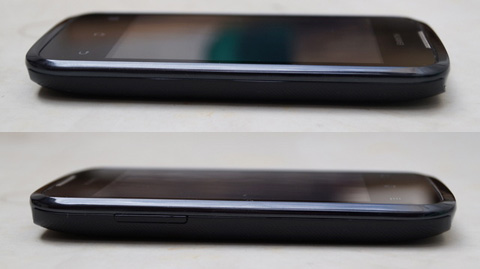
Not much can be found at the right side of the phone.
The volume buttons are made out of rubberized plastic. It’s easy to locate the volume keys without looking at the phone, also, the keys give off a solid and tactile feedback with just the right amount of travel when pressed (no wobbles here).
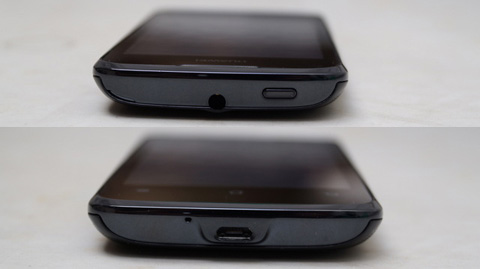
The power/lock key and a 3.5mm headphone jack are found at the phone’s top part, there’s also a nailscoop for prying off the plastic back shell. It’s worth noting that despite the solid feel we get when pressing the power key, it can be a bit hard to press/locate since it’s little too flush with the phone’s chassis — thus, it requires a bit more effort than usual to activate the screen.
Uncluttered with just the micro USB slot and the microphone pinhole found at the bottom.
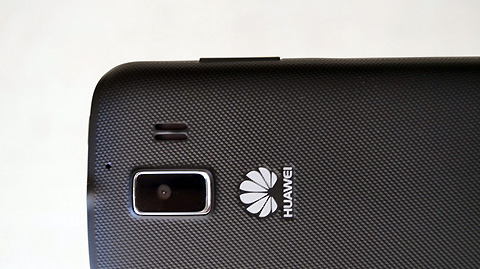
The 3.2MP camera and a speaker grill lies at the back part of the Y200, its back shell is covered in a pattern similar with Samsung’s Hyperskin which aids in keeping the phone from slipping off our sweaty palms while keeping fingerprints away. Another surprise is the tiny hole found near the upper right corner of the camera, a secondary microphone used for cancelling out background noise during calls (more on that later) which isn’t normally included with phones at this price range.
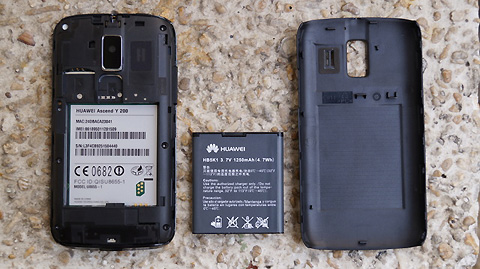
The back cover of the phone is made from a sturdy piece of polycarbonate plastic and needs quite a bit of effort to remove. Once the back cover is off, you can then gain access to the 1,250mAh battery, a regular-sized SIM card slot and a microSD expansion slot.
The overall design of the Ascend Y200 is professional looking despite its relatively cheap price. Once held, the 120 gram weight of the phone gives off a reassuring feel, it’s not too heavy nor light, the weight is just right. Add to that the solid slab feel and an adequately sized 3.5″ IPS display and you’re good to go.
Display
The screen is the main selling point of the Y200 (as we have previously mentioned), while the limited 256k color output and 320×480 resolution are a bit of a disappointment, the 3.5″ IPS display on the Y200 boasts some serious viewing angles. Some of the main competitors within the 6k peso range are the Galaxy Y and Mini phones from Samsung and those things have awful viewing angles (not that everyone composes text messages on their phones from a 140-degree angle), lower resolutions and even smaller screens (240×320, 3.0 -3.15″) apart from the ugly color saturation.

(Note: images may appear pixelated due to the screen’s refresh rate, the phone’s display is a LOT clearer in real life.)
Whether lying on the bed and checking Facebook photos or if viewing SMS upside down, the color of images and readability of the characters on the screen will never appear washed out for sure.
The IPS panel on the Y200 does not make that much of a big deal but at least Huawei has done something to make using the phone more pleasurable without sacrificing the price. The display is the main input of a touchscreen phone after all, so a little improvement goes a long way.
Android OS and the Emotion UI
The Emotion UI is Huawei’s custom skin built right on top of the Android 2.3 Gingerbread OS, upon turning the phone on, first thing we’ve noticed about the interface was the highly functional lock screen. Once the display springs to life, users are greeted by a thin ring with an orb-like padlock inside, placing a finger on top of the orb makes four icons appear around the thin ring where you can drag it to. Dragging the orb to the north brings you straight to the call logs, dragging it to the west opens the messaging app and so on…
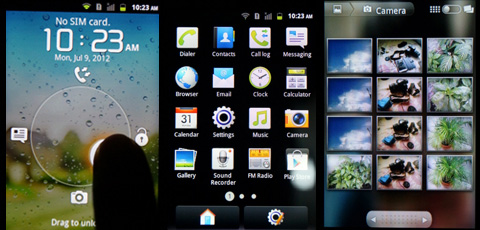
The UI that Huawei has implemented on the Y200 is quite smooth. Scrolling through the homescreens, messages, apps and contacts was buttery. Even the stock Gingerbread gallery was gliding along smoothly, we’re guessing it’s due to the Adreno 200 GPU coming into play, the relatively low pixel count of the display is quite easy to run for the aging graphics processor. We rarely saw stutters and skips. Even adding or dragging widgets is a breezy task — which we cannot say the same even with some higher-end smartphones out there.
Huawei is positioning the Ascend Y200 to compete with other entry-level Android phones like the Galaxy Pocket (and the old Galaxy Y) as well as the LG Optimus L3. Like its big brother, the Huawei Honor, the Ascend Y200 also features a fast boot up time of 5 seconds.
Design and Construction
Huawei has clearly outdone themselves with the Y200, there are a couple of notable surprises included with their entry-level slab of cheap goodness — aside from the great build quality.

We were definitely surprised when we saw the LED notification light, it gives a faint glow of either red, green, blue or orange depending on the current status of the phone. It’s a welcome addition, we rarely see top-end Android smartphones that feature a notification light let alone an entry-level one.
The front fascia of the Y200 possess an eerie reminiscence with that of the HTC Wildfire S and Desire C smartphones. Also, the similar group of three touch-capacitive buttons can be found under the display, it’s up to you guys to decide if this is just a coincidence or not.
Unfortunately, the protective cover of the display is made out of plastic that easily gets scratched — no gorilla glass here (for that asking price? We really can’t complain), the chrome-like black trim that wraps around the edge of the phone is also a fingerprint magnet.
Despite our numerous attempts to exert pressure on the sides and middle part of the display, we weren’t able to see the ‘rainbow effect’ and barely heard any creaking. Huawei did a great job with this thing, It’s on par with the likes of Samsung and Nokia phones’ build quality.

Not much can be found at the right side of the phone.
The volume buttons are made out of rubberized plastic. It’s easy to locate the volume keys without looking at the phone, also, the keys give off a solid and tactile feedback with just the right amount of travel when pressed (no wobbles here).

The power/lock key and a 3.5mm headphone jack are found at the phone’s top part, there’s also a nailscoop for prying off the plastic back shell. It’s worth noting that despite the solid feel we get when pressing the power key, it can be a bit hard to press/locate since it’s little too flush with the phone’s chassis — thus, it requires a bit more effort than usual to activate the screen.
Uncluttered with just the micro USB slot and the microphone pinhole found at the bottom.

The 3.2MP camera and a speaker grill lies at the back part of the Y200, its back shell is covered in a pattern similar with Samsung’s Hyperskin which aids in keeping the phone from slipping off our sweaty palms while keeping fingerprints away. Another surprise is the tiny hole found near the upper right corner of the camera, a secondary microphone used for cancelling out background noise during calls (more on that later) which isn’t normally included with phones at this price range.

The back cover of the phone is made from a sturdy piece of polycarbonate plastic and needs quite a bit of effort to remove. Once the back cover is off, you can then gain access to the 1,250mAh battery, a regular-sized SIM card slot and a microSD expansion slot.
The overall design of the Ascend Y200 is professional looking despite its relatively cheap price. Once held, the 120 gram weight of the phone gives off a reassuring feel, it’s not too heavy nor light, the weight is just right. Add to that the solid slab feel and an adequately sized 3.5″ IPS display and you’re good to go.
Display
The screen is the main selling point of the Y200 (as we have previously mentioned), while the limited 256k color output and 320×480 resolution are a bit of a disappointment, the 3.5″ IPS display on the Y200 boasts some serious viewing angles. Some of the main competitors within the 6k peso range are the Galaxy Y and Mini phones from Samsung and those things have awful viewing angles (not that everyone composes text messages on their phones from a 140-degree angle), lower resolutions and even smaller screens (240×320, 3.0 -3.15″) apart from the ugly color saturation.

(Note: images may appear pixelated due to the screen’s refresh rate, the phone’s display is a LOT clearer in real life.)
Whether lying on the bed and checking Facebook photos or if viewing SMS upside down, the color of images and readability of the characters on the screen will never appear washed out for sure.
The IPS panel on the Y200 does not make that much of a big deal but at least Huawei has done something to make using the phone more pleasurable without sacrificing the price. The display is the main input of a touchscreen phone after all, so a little improvement goes a long way.
Android OS and the Emotion UI
The Emotion UI is Huawei’s custom skin built right on top of the Android 2.3 Gingerbread OS, upon turning the phone on, first thing we’ve noticed about the interface was the highly functional lock screen. Once the display springs to life, users are greeted by a thin ring with an orb-like padlock inside, placing a finger on top of the orb makes four icons appear around the thin ring where you can drag it to. Dragging the orb to the north brings you straight to the call logs, dragging it to the west opens the messaging app and so on…

The UI that Huawei has implemented on the Y200 is quite smooth. Scrolling through the homescreens, messages, apps and contacts was buttery. Even the stock Gingerbread gallery was gliding along smoothly, we’re guessing it’s due to the Adreno 200 GPU coming into play, the relatively low pixel count of the display is quite easy to run for the aging graphics processor. We rarely saw stutters and skips. Even adding or dragging widgets is a breezy task — which we cannot say the same even with some higher-end smartphones out there.









